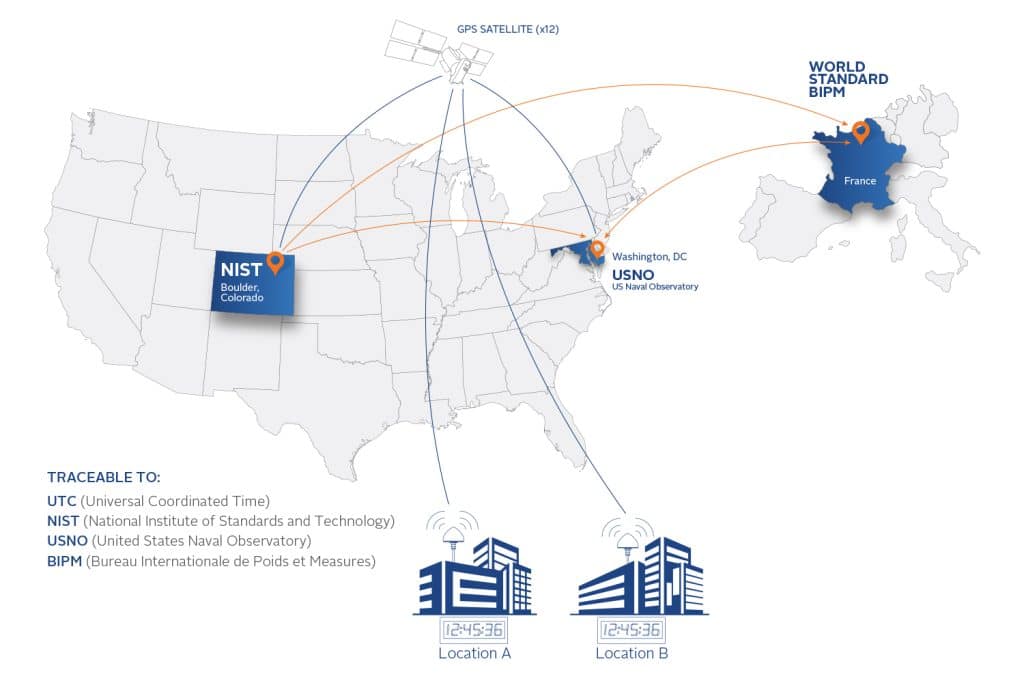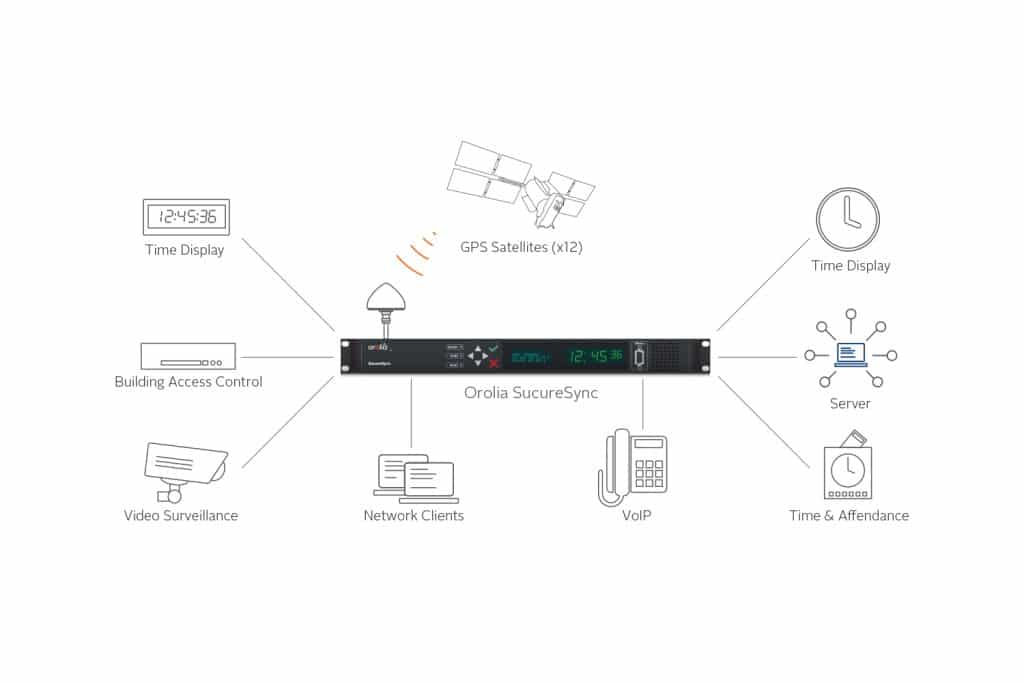# White Papers
Synchronized Time Improves Healthcare
Executive Summary
As the healthcare industry embraces technology to improve patient care and reduce costs, integrating disparate systems is critical to maximize performance. Something as simple as a common basis for timekeeping can make a difference in records accuracy, device and system interoperability, security, regulatory compliance, and overall efficiency of operations. Because technology implementations are network-centric, timekeeping in software and hardware can be easily synchronized to the official worldwide time standard.
Introduction
- It’s only a matter of time before one of these happens to you …
- A new quality initiative or pay-for-performance policy requires documentation of times of diagnosis and treatment, but you cannot comprehend records that indicate which patients have received care before being admitted.
- Worse, your legal department and compliance officer have raised serious doubts about the accuracy of your records — just as the family of a patient files a lawsuit claiming that the patient did not receive timely care.
- Your new health information technology network has been hacked and no one can understand the extent of the intrusion.
- Your new access control security system has locked out your staff or prevented you from accessing critical documents.
- Your systems are not synchronized with each other, resulting in crashes, data conflicts and scheduling problems.
- Your Cybersecurity policy no longer permits you to keep a port open to the outside world just for getting time off from the internet.
The list of problems goes on and on. Yet all of these issues can be traced to a single, critical factor: Time. Time affects every aspect of the health care organization:
Nurses and Doctors rely on time to maintain accurate schedules and records, such as determining when the last patient’s procedure or test was performed, or medication administered, and when the next will be.
Facility and engineering staff work to make sure the hospital infrastructure is accurate, trouble-free and properly maintained. Accurate time must be set and maintained for everything from wall clocks and medical devices to closed-circuit TV monitors and access control systems.
Information Systems staff need a time reference to support accurate time stamps and log files for their software systems and hardware, including firewalls, routers, servers and workstations. This is necessary for records accuracy and interoperability, to detect and correlate the effects of network intrusion and to support the latest encryption and authentication standards. Time initiates processes such as backups, reconciles database transactions and is used for troubleshooting.
At the executive level, accurate time is important to ensure compliance to regulations, improve the use of resources through coordinated schedules and reduce the risks of liability, because records are used as legal evidence. Accurately time-stamped records are used for everything from insurance investigations to the reconstruction of emergency events, sometimes in conjunction with outside agencies (such as EMS and 911).
Finally, billing and insurance providers need accurate records of procedures, admittances and discharges and to verify times of birth and death.
In the past, when time was different among the various areas of the health care facility, disparate time was merely an inconvenience. But as systems have become increasingly interconnected, synchronized time throughout the health care enterprise becomes critical for regulatory compliance, to reduce legal liability, increase efficiency, and to improve care.
Time: Vital for Patient Care
When accurate time matters, clocks need to be synchronized to each other. Members of law enforcement or a military squad compare and reset watches to synchronize operations as a matter of life and death. Similarly in healthcare, synchronized clocks are an enabling tool to improve the quality of healthcare to save more lives.
Nowhere is this more important than in emergency medicine. For example, the treatment of heart attack victims is a race against time. Cardiologists know that “time is muscle.” The sooner that blood flow can be restored in patients with blocked arteries, the more likely the heart can be saved.
Quality management principles apply to any improvement program, including reducing the time of diagnosis and treatment. However, you cannot improve what you can’t measure. Variance in clocks results in variance in performance, even before any other variable is taken into account. That’s why the patient advocacy group, the Society of Cardiovascular Patient Care, looks for synchronized clocks in their accreditation process. According to former Executive Director Robert Weisenburger Lipetz, “Reducing time to treat heart attack victims is critical to successful patient outcomes. Accurate coordination of times among EMS, the emergency room, the cardiology department, and the catheterization lab, is essential for facilities to accurately measure and thus control the related processes for the care of ACS⎯acute coronary syndrome.”
Time-based benchmarks set the standards for quality care. For treatment of blood vessel obstruction as the cause of ACS, the current benchmark for the time from hospital arrival until the blockage is relieved (“door to balloon”) is about 90 minutes. With the multitude of processes involved in diagnosing and treating chest pain, every minute counts. Without synchronized time in the facility, it is impossible to accurately document performance or reconstruct events for process improvement. New pay-for-performance scenarios can impact financial performance if facilities cannot document time-based improvements in metrics such as door to balloon.
Time in the Electronic Health Record
Technology efficiencies in the health care industry are made possible by interoperable devices and systems that share data in real time. Electronic health records (EHR) are one result of a data-sharing network that is used throughout the health care system. Although the potential benefits and efficiencies of EHRs are well-known, the industry is still working to understand and overcome the challenges of “wiring” operations. Significant issues include compliance with industry regulations, data security, patient privacy, records accuracy and interoperability of systems, networks, devices, operating systems, and applications.
A time-synchronized network, in which all computer clocks are generating accurate and identical time stamps, plays an important role in addressing all these challenges. Without time synchronization, the reliability of every record can be questioned. For example, a valid and legal medical entry must address the following questions:
Who did it? An authentication system is required to identify the user of the system. Authentication standards require time synchronization between clients and servers for many implementations, because time-based “tickets” are used to thwart replay attacks that are attempts to gain unauthorized access to the system.
When did they do it? Accurate time stamps traceable to worldwide time standards tell us when an event truly occurred.
What was done on the system, and did anyone tamper with it? Accurate time stamps and log files are used to perform audits to detect suspicious activity and assess its scope.
Best practices and industry regulations, including HIPAA, Medicaid/Medicare and the Joint Commission, require accurate time-based computer records. Over the past several years, organizations and initiatives such as Health Level Seven (HL7), Integrating the Healthcare Enterprise (IHE), the Certification Commission for Health Information Technology (CCHIT), and others recognize time synchronization as a critical compliance component for EHR interoperability and security. As an example, the IHE has developed the Consistent Time profile as an integral requirement for healthcare network deployments. Consistent Time ensures that system clocks and time stamps of all the computers in the network are well-synchronized with a median error of less than one second.
Synchronization to Legally Traceable Time
One of the subtleties of time synchronization is the need for accuracy traceable to official time vs. uniformity between just a few clocks. Time is one of the seven legally-defined units of measure. Since the Treaty of the Meter of 1875, time has been coordinated worldwide. Today, official time known as Coordinated Universal Time (UTC) is measured by vibrations of the cesium atom, an extremely accurate time constant. (UTC replaced Greenwich Mean Time [GMT] in 1972.) UTC is kept by and synchronized between national metrology institutes like the National Institute of Standards and Technology (NIST) in Boulder, Colorado.
By establishing traceability to NIST, you are assured that your synchronized clocks are providing accurate time to provide the following
benefits:
- Your data is synchronized with the records of any other system using traceable time, a critical issue for Regional Health Information Organizations (RHIOs).
- Courts have upheld NIST-traceable time stamps to be legally valid. Accurate time-stamps support the legal requirements of medical records.
- Hospital events can be correlated to other events such as 9-1-1 calls.

GPSGlobal Positioning System is a navigation satellite system. See also provides a convenient method for distributing official time so every facility can be synchronized.
Implementing a NIST-traceable time synchronization system is made easy thanks to the Global Positioning System (GPS). GPS provides a secure and cost-effective way to provide a traceable time synchronization source to a facility. The GPS system includes 24 satellites carrying onboard atomic clocks. The U.S. Naval Observatory monitors the satellites’ clocks and locks them to UTC for accuracy and traceability to national and international standards. We are all familiar with the use of GPS to provide precision positioning. GPS receivers use synchronized time and the principle of triangulation to calculate the three-dimensional position anywhere on earth. The same GPS signal can also be used to synchronize a local “master clock” that is used to distribute time to every clock in a facility.
A Network Appliance Manages Time
In a synchronized time deployment, clocks are arranged hierarchically where a time client receives its time from a time server. Any computer can be configured to operate as a time server. Time servers are available on the Internet. The major benefit of Internet time servers is that they are free. Their primary liability is that their use requires continuous Internet connectivity and an open port in the firewall ⎯ a risk that most security-conscious IT managers are reluctant to take. What’s more problematic, however, is that the accuracy of these free sources cannot be verified and there is no traceability path to prove accuracy. Using a time source “outside the network” is a liability and should be considered only after thorough review with IT security, compliance officer, risk manager, and legal department.
A GPS-enabled network time server, such as Safran’s SecureSync® is a network appliance for time-synchronizing the healthcare enterprise. For reliability and security, it operates safely behind the firewall to synchronize all elements of network hardware and software down to the millisecond over LANs or WANs, anywhere on the planet. Its accuracy is guaranteed by tracking 12 or more satellites with state-of-the-art error checking algorithms. Its security and manageability is based on a wide variety of network protocols to ensure simple and safe configuration, control, and monitoring. Its traceability is verifiable through extensive logging capabilities.

An easy-to-install and manage network appliance serves accurate and secure time to virtually any system clock, including facility clocks via a wireless transmitter.
Leveraging Time Across the Healthcare Enterprise
A GPS time server provides an integrated solution that enables accurate timing for computers and other elements of the network infrastructure (routers, firewalls, etc.) as well as non-traditional network devices such as video surveillance, access control, time and attendance, telephony, and more. Virtually any IP-based system can be easily synchronized by configuring network time protocol (NTPNTP, or Network Time Protocol, is a widely used networking protocol that enables computers and devices to synchronize their system clocks with a reference time source. It ensures accurate timekeeping in computer networks by allowing devices to obtain precise time information from NTP servers, which are typically synchronized to highly accurate atomic clocks. NTP is essential for various applications and services that rely on synchronized time, such as network security, authentication, and data logging.) in the operating system or software. NTP is an “open source” time synchronization distribution standard. It is supported and NTP client software is typically pre-installed in all network systems.
A time server can be used to synchronize non-network-devices. Serial communications, event relays to activate a switch at a precise time, and add-on radio transmitters to synchronize wireless devices, such as facilities clocks, are available in network time servers to provide legally traceable time to other time-sensitive devices.

Seemingly unrelated systems can be integrated through a common time source.
Conclusion
As data-sharing in health care continues to be the basis of new technology deployments, errors resulting from clock drift or from setting device times manually is a risk to operational efficiency. Time is critical for patient care, network security, interoperability, quality initiatives and regulatory compliance. Synchronized time using a network appliance facilitates efficient and trouble-free operation for a wide variety of systems including those maintaining electronic health records. The result of a small investment in legally traceable time for your entire healthcare enterprise offers a large reward knowing that it is no longer a “matter of time”.


